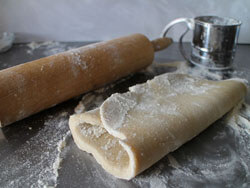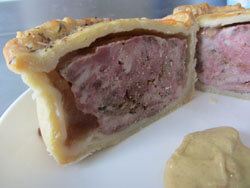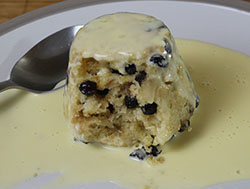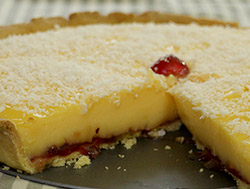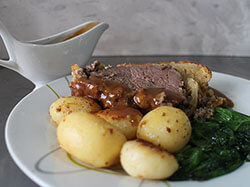
Big Pork Pie - Stand Pie
Introduction & method
This big pork pie is made for sharing. It appears at Christmastime in Yorkshire, although I dare say other regions have them and you can get them all year round. 'Stand' is short for 'standing', because this is a raised pie that's made around a former. At first glance you might mistake this stand pie for a Melton Mowbray pie, but it isn't. The main difference is that the pork in a stand pie is cured, making it pink. The meat in a Melton Mowbray pie is not cured and takes on a greyish colour.
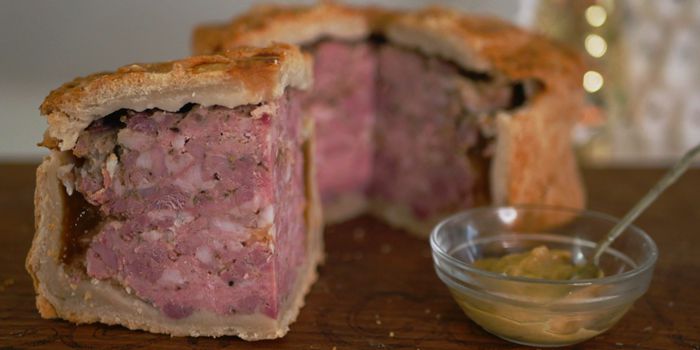
About the Meat
Pork shoulder is the preferred meat for this, although I have used belly or chops, and quite often some pork mince because all that chopping is tedious. The weight given here is the finished weight after skin and bones have been removed.
Find a Former
As this is a raised pie, you need something to raise the pastry around. If you plan to make these pies frequently, you might invest in a pie dolly - this is a drum of wood with a stick handle protruding from the top. Alternatively, use a biscuit (cookie) tin or similar. The one I use is 14cm (5½ inches) diameter, 9cm (3½ inches) high.
Make Hot Water Pastry
Pork Pies are traditionally made with hot water pastry - it's very robust and super-easy to make. In a large bowl, mix together the salt and flour. In a small saucepan, add the water and the lard cut into chunks. Heat the pan until the fat has all melted but do not let the water boil. Pour half of the liquid into the flour and stir until it's combined, then add the rest of the water and combine that. Grab the dough, give it a light kneading to make it smooth, then wrap it and leave to cool. It's very difficult to use the dough when it's too hot. But it's also hard to use straight from the fridge. Ideally, you want it just above room temperature.
Prep the Meat
The meat should have a slightly chunky appearance with small blobs of fat mixed in. To achieve this you need to hand-cut the meat and fat into 5mm (quarter inch) chunks, but this is incredibly labour-intensive so I often use 50% minced pork in with the chunks. Seasoning is vitally important for this. The recommended amount is 11 grams (0.4 ounce) per kilogram (2.2 pounds). If you make up this mixture in a small jar, you'll have enough for 2 pies: 6 tsp ground white pepper, 4 tsp salt, 1 tsp dried sage and half a tsp mace (or nutmeg if you can't get mace). You'll also need 5 grams (0.2 ounce) of curing powder - variously sold as Instacure™, Prague Powder #1 or just plain old sodium nitrate. Mix it thoroughly with the seasoning mix before mixing that very thoroughly with the meat. Form the mixture into a drum shape that fits inside your former and comes up almost to the rim. Wrap tightly in film and refrigerate until needed.
Form the Lid and Case
For the lid, roll out about a quarter of the dough on a floured worktop. You'll need a disc that's about 1cm (half an inch) larger than the tin to account for the thickness of the case on the outside of the tin. It should be fairly thick - 6-7mm (3/8 inch). Cut a hole in the centre with the tube end of a funnel.
For the case: wrap the outside of the tin with greaseproof paper (baking parchment). Do this by placing the tin in the centre of a sheet of paper that's a square 4 times the diameter of the tin. From the edge of the tin to the edge of the paper, cut the paper into strips. Fold these strips up the side of the tin and down into the inside. You might want to try securing the strips with Sellotape - it won't be perfect, but it will hold them enough. Now, roll out the remaining dough into a puck, bigger than the tin diameter and quite thick. Use your knuckles to press the centre of the puck down to 6-7mm thickness. Place the tin on this, then using all four of your hands, gather the dough and coerce it up the side of the tin. At some point you'll decide it would be easier to flip the whole over and work the dough down the side. Be very careful not to squeeze the dought too thin or to break it. The edge of the tin is especially vulnerable to breaking, so keep an eye on it.
When the dough reaches to the rim of the tin, pop it in the fridge to rest for several hours (or overnight), until it's firm enough that it can stand on its own.
Assemble the Pie
Get the case from the fridge. unfold all the paper strips on the inside of the tin. Lift the tin out, then peel the paper away from the inside of the pastry. Thoroughly moisten the rim of the case, then unwrap the meat filling and place it in the case. The meat should be 1cm (half-inch) below the rim. Place the lid on top of the meat and squeeze the edge together with the rim of the case. Crimp the edge or just press it down with the tines of a fork. If you want to cut out pastry leaves, berries, vines etc, now is the time to do it and stick them on the pie with a little water. Put the pie back in the fridge to rest for at least half an hour.
Bake the Pie
Heat your oven to 180°C (356°F) for a fan/convection oven, 200°C (392°F) conventional, gas 6. Place the pie on a piece of greaseproof paper on a baking sheet. Beat an egg with a bit of milk and paint the pie all over. Place in the oven for 30 minutes, then turn down the temperature to 160°C (fan), 180°C (conventional), gas 4 and bake for another 45 minutes. Check the internal temperature - it should be at least 74°C (165°F).
Jelly Stock
A key feature of pork pies is the savoury jelly that fills the gap between the pastry and the meat. You can make it with gelatine or agar agar, but the traditional way is to use a pig's trotter. You can make the jelly in a pressure cooker in about 30 minutes, or a regular saucepan in 2-3 hours, or a slow cooker / crockpot 6 hours or overnight. Simply place all ingredients in the vessel of your choice, cover with water and cook for the time shown above. When the cooking is done, strain the stock through a fine sieve lined with muslin cloth. Test the jelly set by putting a small amount in a shot glass and placing it in the freezer for 10 minutes - it should be set or starting to in the time. If it isn't setting, boil the stock rapidly to reduce it somewhat.
When the pie comes out of the oven, leave it for about 15 minutes to settle down, then put it on a wire rack, stick a funnel in the hole in the top, and pour in some jelly. If might help things along if you make a small hole near the rim with a skewer to let air out. Keep an eye on the worktop for any leakage - if you have holes, it might be possible to plug them with a bit of leftover dough.
These pies are usually eaten cold when the jelly has set, and mustard picallili is a traditional accompaniment.
Ingredients & Info
HOT WATER PASTRY
 350 grams plain (all-purpose) flour
350 grams plain (all-purpose) flour 120 grams lard
120 grams lard 150 ml water
150 ml water 1 tsp salt
1 tsp saltFILLING
 1 kilo pork shoulder
1 kilo pork shoulder 11 grams seasoning mix (see 'Prep the Meat' below)
11 grams seasoning mix (see 'Prep the Meat' below) 5 grams Prague Powder #1
5 grams Prague Powder #1JELLY
 1 pigs trotter
1 pigs trotter 1 medium onion
1 medium onion 3 bay leaves
3 bay leaves 1 tsp salt
1 tsp salt 1 tsp white pepper
1 tsp white pepperPrep time: 1 hour.
4 hours time: Resting/cooling.
Cooking time: 90 minutes.
Total time: 6 hours 30 minutes.
